Magnificent Obsession
![]()
Magnificent Obsession |
|
by Glyn D. Russell
|
This article appeared in the March 1999 issue of Falco Builders Letter. |
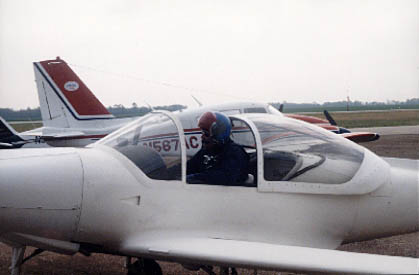
Carlton Bailey ready for the first flight with fire retardant
clothing, helmet and parachute
The Airplane
This story began fifty-six years ago. I was four years old watching
Army-Air Force maneuvers on our farm in middle Tennessee. The
big radial-engine airplanes would make practice bombing runs dropping
what appeared to be sacks of flour on targets. Occasionally, paratroopers
would jump for practice. I suppose they were from Ft. Campbell,
KY, which was about fifty miles away. I would watch these airplanes
with all the sights and sounds during the day, and I would dream
about them at night.
So you could say that I have had a life-long love of airplanes. When I was about seven years old, I had my first ride in a barnstormer's airplane. He came to our community, landed in a hayfield and gave rides to anyone who had the three or four-dollar fee. It was probably in a Cub or Champ. I remember the feeling but can't remember how the airplane looked.
In my teens, working in the hot dusty fields, I would imagine some day flying my own airplane. Daydreaming about landing in the small field that I was working in was not very difficult. During this time, I read everything that I could get my hands on about airplanes and continued to dream. Rockford and the EAA were just in their infancy, but Rockford was a million miles away to a kid growing up in Appalachia.
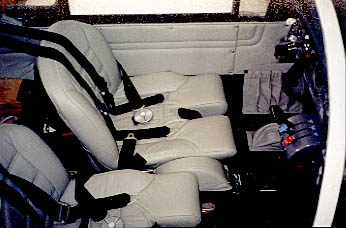
I got my private license in 1972, then completed the commercial, instrument, and multi-engine through the G.I. Bill. I owned a partnership 172 then upgraded to a partnership 182. Both of these partnerships worked out very well, but my three children came along about that time, and I couldn't afford the time or the money to indulge my expensive hobby. So I put flying on the back burner for a few years.
In 1980, I began to go to Oshkosh and have made the annual trek every year since that time to O.D. on airplanes. About 1989, late on a bright sunny Sunday afternoon, Pawel Kwiezinski took off on Runway 18 in his Falco. I happened to be sitting along the flight line enjoying the lovely summer afternoon sprinkled with departing airplanes. He pulled the Falco off, retracted the gear, held the airplane about twenty feet off the deck and flew all the way down 18 at that level. What a beautiful sight and sound. That is a memory that I believe will stay with me forever. I was eternally hooked on the Falco.
On the way back home, somewhere south of Chicago, my brother-in-law, Paul Montgomery, looked over at me and said "You could build one of them, couldn't you?" I thought about that for the next six hundred miles as we drove home.
The Project
I got up enough courage in October to call Sequoia and inquire
about the plans. Alfred asked me about my background and abilities.
I told him that I had built some small pieces of furniture out
of wood and that I was a pretty good shade tree mechanic. I ordered
the plans. When they arrived, I was so excited that I sat down
and went through the entire stack at one sitting.
I was terribly overwhelmed. I became discouraged with the huge scope of the project and felt that I could never undertake building such a complicated machine. My mistake was obviously trying to comprehend the entire scope rather than a small piece at a time. A couple of weeks of contemplation helped me to put the challenge in a better perspective. I decided to proceed and see how far I could go.
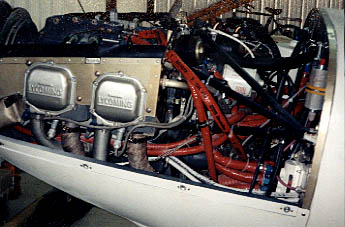
The spruce and plywood were ordered and arrived in a few days. I began building on the tail ribs then proceeded to the wing ribs. Tremendous enjoyment working with the wood! My plan at the time was to build everything possible from scratch thereby minimizing the amount of money that would be needed to complete the plane. After a year of building, I realized that I was not going to be able to complete the project in this lifetime. Great spare time fun, but terribly slow progress.
In talking with Alfred, he mentioned that there was a project in Springfield, IL owned by John Kerasotas which was for sale. A trip to Springfield and a visit revealed that he had a good project on which he had done quite a bit of work. The workmanship was excellent, and nothing was closed. John was a cabinet builder by hobby and had done just beautiful work. He had recently bought the flying Falco that Tony Bingelis built so I think John had lost interest in his building project. He had the first eight or ten kits on hand. I bought them and trucked them back to Alabama.
The wing and tail ribs that I had spent a year building were packed up in boxes and stored away. Seed for my next project. We began to build using a different approach-building with kits. But first, a bigger shop had to be built since the twelve by eighteen workshop that I began the project in obviously wouldn't handle the length of the main spar. We built a twenty-eight by thirty on property that we owned next to the house.
Alfred sometimes surprises me with his words of wisdom. One of these surprises was his recommendation that you keep the project close to home. This is very important as you go forward with building. It was very easy to run out to the shop and work for a few minutes at a time. This convenience is helpful amid all the frustrations of building.
I set completion goals many times during the process and continued to miss them. Finally, a serious goal of April 1998 seemed to be possible. I only missed that by one year. The tedium of finishing all the minute details seemed to be eternal. Some of the more serious aggravations were little details like the fuel gauges wouldn't work when the panel was installed. The panel was removed a couple of times because of this problem. After spending days on this small deal, Alfred suggested installing the panel and putting fuel in the tanks. He said this sometimes took care of the problem. It worked.
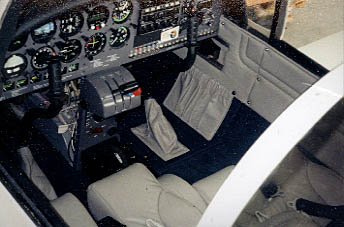
There were many, many other small problems that had to be solved. Finishing up takes a huge dose of patience. I remember Steve Wilkinson saying that they are never finished, and I subscribe to that thought. After eight years and twenty-eight hundred hours, it was as finished as possible.
Time for the FAA inspection. This went very well. There were only very minor defects. We didn't have fuel capacity placards installed. Also, the cabin heat and defrost knobs were not identified. One other problem was noted. Apparently, there is a relatively new law which requires a placard on the outside indicating the make and serial number of the aircraft. A small placard under the horizontal tail took care of the defect.
There were no airframe or engine defects noted during the inspection. I had already used the services of a working A&P to inspect prior to the FAA. Thirty-one minor defects were corrected. These were things like adding another washer in a place or two and cleaning up the ends of cotter pins.
The upholstery that I selected was light gray leather complimented with ocean blue carpet. The equipment is what I consider to be standard Falco including a Century I autopilot, an inverted fuel, Christen inverted oil system, and an M1 Loran which will probably be replaced by a GPS in the future. The engine is a Lycoming IO-320-BlA which was zero timed by Clark Aviation in Bay Minette, AL.
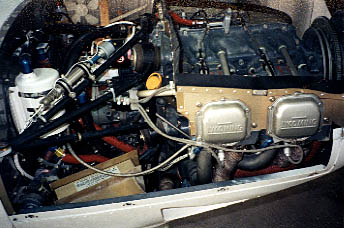
I must thank a number of people here who have given me so much support and assistance over the years. To Alfred and Susan for all the customer support they have given me over the years. Their customer service is second to none. Answers to my numerous phone calls and faxes were extremely prompt (usually within an hour) and right on target. Good questions and dumb questions got the same courteous, polite responses. Thank you so much for all you have done.
To Clay Smith and his staff at Decatur Athens Aero Services in Decatur, AL. I have worried them to death over the past few months with questions about how to do a jillion little details on which I didn't have a clue. They are tremendously supportive of home builders.
Stan Smith aired up the struts so many times that I'm embarrassed to ask him again. (This problem was eventually solved by replacing one of the struts and then putting eight hundred pounds of pressure in both sides.)
To my son Chris, an engineer, who helped me on the project at every opportunity that he could find. He got his PhD from Virginia Tech during the construction so his time was somewhat limited. I think he enjoyed building as much as I did. His engineering assistance was invaluable.
To Robert Conklin, who helped me with the firewall forward, the panel installation and many other problems. Robert is an AI and his work in connecting wires, gauges, etc. under the cowling and behind the instrument panel has been extremely helpful. I found the engine installation to be very difficult for my ability. This was compounded by the Christen inverted system and the fact that I had never done an engine installation before this one.
Thanks to my test pilot, Carlton Bailey, who gave the project life. Finally, thank you to my wife Jonnie and other family members who put up with my Falco obsession for so long. I appreciate you allowing me the pleasure of building.
First Flight
After the FAA gave their approval, it was time to approach the
challenge of the first flight. We needed a test pilot. I was not
the right person, no doubt about it. We interviewed a couple of
people who had expressed an interest in doing the first flight,
but we didn't feel that the right person had been found.
I was walking through the airport lounge one day and Carlton Bailey, who I knew only casually, asked me, "How does the Falco fly compared to the SF.260?" I confessed that I didn't have a clue since I had not ridden in either. I went ahead to tell him that I thought they were somewhat similar in flying characteristics. I asked him if he had any interest in doing the first flight. He indicated that he would like to talk about it and see if we could reach an agreement. It turns out that Carlton is a CFII, and an Air Force Reserve pilot who is currently flying B-52s. He has more than six-thousand hours in everything from Luscombes up to...
I was most impressed by his more than two hundred hours in SF.260s at Fighter Town in California. After extended discussions, we agreed to have him do the first flight.
The next challenge was to get some insurance. This turned out to be very difficult, expensive and restrictive. I think insurance will be almost impossible to buy on complex experimentals in the near future. I was able to find one carrier who would sell me coverage. The coverage is only good if Carlton flies off the first twenty-five hours then gives me five hours of dual. This was disappointing but not the end of the world. Since I am the careful, conservative homebuilder that I am (now that's an oxymoron) I plan to abide by the rules. Can't afford to take the risk, otherwise.
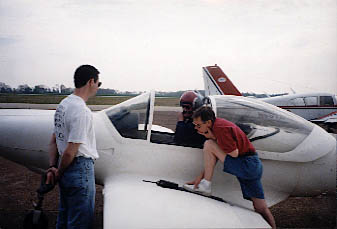
Chris Russell, Carlton Bailey and Glyn Russell make plans for
the first flight
The big day came. April 3. Carlton and I were both very nervous. He had never done a first flight other than "after maintenance" flights, and I had never built anything to fly. Carlton had prepared a flight test plan right out of The Falco Flight Test Guide.
He was going to do a couple of high speed taxi runs to get familiar with the handling characteristics and test the brakes and systems. The first run went great. When he throttled up to begin the second test run, fuel sprayed out of the fuel pressure hose area on the back of the instrument panel and through osmosis came through the panel around the gauge. Carlton noticed a small curl of blue smoke which apparently came about when the fuel shorted against the alternator circuit breaker.
He immediately applied the brakes and got out. A fire truck was standing by in the area but was not needed. Supreme disappointment! We thought the fuel gauge was faulty and had allowed fuel to collect in the gauge then spill out the front. I pulled the gauge and sent it back to Aircraft Quality Instruments where it was checked and found to be perfect. We believe now that what happened was we had a loose fitting on the fuel pressure line where it attaches to the gauge. This allowed a small quantity of fuel to escape and put a few more gray hairs in Carlton's thirty-six-year-old head.
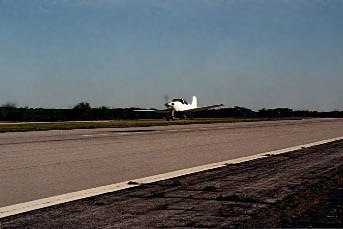
Liftoff on the first flight
The gauge is reinstalled. Checked out. Time to try again. April 18. Same flight plan as before. Carlton did two high speed taxi tests. No leaking fuel this time. On the third run, he broke ground and turned my three-wheeler into an airplane. I cannot find the words to express my joy and elation on seeing N72GR break ground for the first time. It was wonderful! All I could do was stand there in awe with tears running down my checks and dripping off my chin.
Minor problems with the first flight. The transponder didn't work. We are in Class C airspace and the Huntsville, Alabama controller would not let Carlton climb above eighteen hundred feet and enter controlled airspace. So Carlton had to leave the traffic pattern and proceed to the practice area.
This caused a serious worry on my part. I could envision all the things that might go wrong on a first flight. Fuel starvation, engine seizure and a thousand other things were certainly possible. Fortunately, nothing went wrong. Carlton flew for an hour, came back and did a beautiful landing in a direct crosswind at twelve knots gusting to eighteen.
When he had landed and taxied up to the hanger, he said "You've built a good flying airplane-No, let me rephrase that, you've built a GREAT-flying airplane." Nice comment. All I could do was grin.
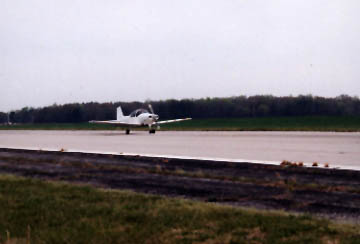
The first landing
|
|